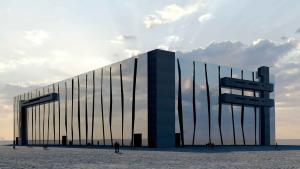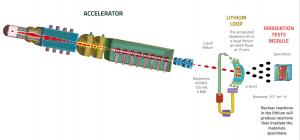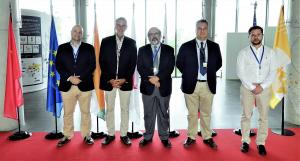Breaking ground at IFMIF-DONES
Construction is now underway in Granada, Spain on the IFMIF-DONES project (International Fusion Materials Irradiation Facility-Demo Oriented NEutron Source). The facility aims to solve one of the key roadblocks towards harnessing fusion for large-scale electricity production—figuring out which materials are sufficiently resistant to the neutron irradiation that will be present in next-generation fusion reactors. The ITER Newsline spoke with IFMIF-DONES Director Angel Ibarra to learn more.
The fast neutron produced in a deuterium-tritium fusion reaction is both a blessing and curse for humanity's ability to harness nuclear fusion for energy. On the one hand, the conversion of the neutron's high kinetic energy into heat as it passes through the walls of the tokamak allows for significant power generation. However those same high-energy neutrons, over a period of sustained bombardment, cause material degradation through the process of transmutation. As the neutron passes through material, it can knock atoms out of their lattices or cause nuclear reactions, causing swelling, creepage, and embrittlement, as well as inducing radioactivity in wall materials.
ITER's levels of neutron irradiation, while significant, will be many orders less than that of the next-generation reactors planned after it. Called Demonstration Power Plants (DEMOs), these reactors will sustain long burning plasma pulses on a routine basis to demonstrate electricity production. More burning plasma time means more fusion reactions, which in turn means more free neutrons released to the walls, which in turn means more materials transmutation and activation. The level of neutron irradiation planned for such a reactor has therefore never been tested. In order to build DEMOs out of materials that can withstand such harsh bombardment, developers are looking to neutron sources as a way to mimic fusion conditions for materials testing.
Europe's solution to the materials question is the IFMIF-DONES project. This materials testing facility, under construction in Granada, Spain, will simulate DEMO-like conditions for potential structural materials. IFMIF-DONES will use a particle accelerator to produce a continuous-wave deuteron (D+) beam aimed at a target made of a liquid lithium curtain. The interaction between deuterium and lithium will generate enough free neutrons to simulate the planned neutron flux over time of Europe's DEMO, which is being designed by the DEMO Central Team at EUROfusion. Directly behind the lithium target will be the high-flux test module, which will house capsules of material samples for neutron irradiance testing.
"A key use of the IFMIF-DONES facility will be the testing of EUROFER, the reduced activation steel alloy currently intended to serve as DEMO's first wall structural material," explains facility director Angel Ibarra. "It is important to do these experiments in a fusion-like environment as soon as possible to validate this material for Europe's DEMO. We'll be testing hundreds of samples of EUROFER and EUROFER-like alloys under varying conditions of neutron and heat flux to gain a fuller understanding of its mechanical properties."
Beyond EUROFER, Director Ibarra clarified that it is not IFMIF-DONES' responsibility to choose what materials to test, but rather to ensure the European fusion community has a proper fusion-like neutron source to test any material sample potentially needed for DEMO use. In essence, IFMIF-DONES will build a database of relevant materials over time.
Thus, while ITER is helping Europe to understand how it should build its DEMO machine by providing a proof of concept for burning plasmas with fusion energy gain in a tokamak, IFMIF-DONES will provide answers as to what materials DEMO should be built with.
Areas for collaboration include knowledge management and technology. "Both success stories and lessons learned from the ITER Project's last fifteen years can help optimize IFMIF-DONES operations as the facility enters its construction phase," explains Ibarra. "Also, some technologies already developed for ITER will also be needed in our project, and perhaps the development process can be streamlined." Furthermore, Mr. Ibarra explained that IFMIF-DONES, once operational, would also be willing to assist ITER's plasma operations by testing ITER materials under a full neutron spectrum.
While IFMIF-DONES will validate materials for a European DEMO, in Ibarra's estimation any nation interested in developing a fusion energy source will need a similar facility for materials testing. IFMIF-DONES is currently engaged in discussions with a number of countries, both inside and outside the European Union, about potentially joining the IFMIF-DONES project. However, whether other countries become IFMIF-DONES members, or use lessons learned from the project to build their own materials testing facilities, Director Ibarra feels that the IFMIF-DONES facility is a "neutron source that could make history" by creating a roadmap to validate materials in a fusion-like environment. In doing so, IFMIF-DONES can help move the worldwide fusion community towards the DEMO stage.
For more information on the IFMIF-DONES project click here.




